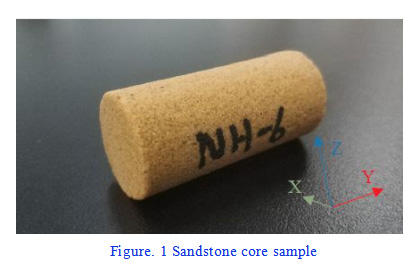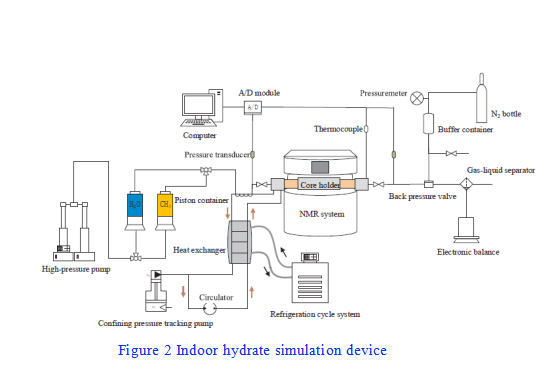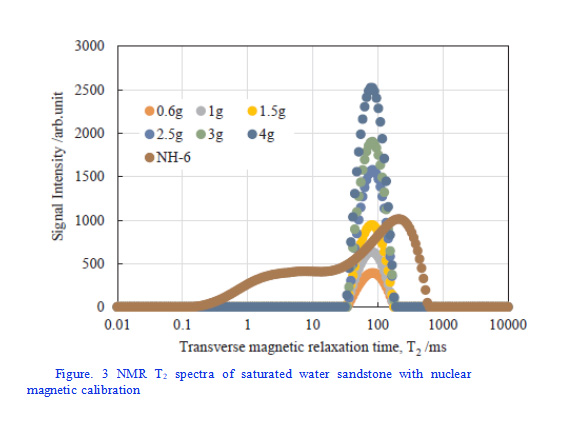In recent years, as a clean and efficient new energy source, natural gas hydrate has gradually attracted attention at home and abroad. However, China is rich in natural gas hydrate resources, including 1.53×1014 cubic meters of geological resources and 5.3×1013 cubic meters of recoverable resources. Different from conventional natural gas reservoirs, hydrate reservoirs have complex and diverse mineral compositions. The sediments are mainly argillaceous siltstones, and the pores are mainly developed with small pores and extremely low permeability. Today I bring with me an SCI paper on laboratory simulation of hydrate formation published last month in Fuel, the top journal of the oil and gas industry, to analyze how to use the sword of low-field nuclear magnetism to explore the conditions and rules of hydrate formation.
1 .Thoughts
The most important method in this paper is how to calculate the amount of gas hydrate by nuclear magnetism. We know that nuclear magnetism measures the mass of water, so liquid water is converted into solid water during hydrate formation, and hydrogen nuclei in solid water do not generate signals. At the same time, we know that the hydrate formula is CH46 (H2O), that is, six parts of water is reduced to produce one part of hydrate. In this way, the saturation of hydrate can be calculated by nuclear magnetic field to calculate the decrease of liquid water signal. It should also be noted that although the hydrogen in the methane gas also generates a nuclear magnetic signal, it is extremely weak compared to liquid water, which is ignored here.

2.Principles
The low field NMR technique is a physical process in which the hydrogen nucleus of a reservoir fluid absorbs a certain frequency of a radio frequency pulse and recovers the equilibrium state after NMR. The transverse relaxation time T2 of the hydrogen nucleus is analyzed to analyze the storage. Fluid characteristics in the pores of the layered rock. The distribution characteristics of reservoir fluid T2 are affected by three relaxation mechanisms: surface relaxation, bulk relaxation and diffusion relaxation, which can be expressed as:
T2S —surface relaxation, ms;
T2B—body relaxation, ms;
T2D —diffusion relaxation, ms;
In this experiment, the uniform magnetic field is adopted, so diffusion relaxation is not considered. Moreover, due to the strong interaction between fluid and pore surface in rocks, the surface relaxation time T2S of reservoir fluid is much smaller than the body relaxation time T2B, so 1/T2B can be ignored. The above equation can be further expressed as:
Where, S is the surface area of pores; V is the volume of pores;
Further expressed as:
It can be seen that the rock relaxation time T2 is proportional to the pore radius and inversely proportional to the relaxation rate. The shorter the relaxation time is, the smaller the pore radius is.
3 .Procedure
The low – field NMR analyzer was MacroMR12-150-I produced by Suzhou Niumag Company. The permanent magnetic field intensity of the instrument is 0.3T and the coil diameter is 70mm.
This experiment is to explore the formation process of hydrate in partially saturated water sandstone by using the excess gas method. During the formation process of hydrate, the temperature and pressure conditions remain constant. The connection of the experimental device is shown in Figure 2. The specific experimental process is divided into the following six steps:

(1) The core gripper is maintained at 2°C with the cooling circulation device, and then the nuclear magnetic signal is calibrated with the standard sample containing heavy water. The calibration results are shown in Figure. 3. There is an excellent linear relationship between the water quality and the nuclear magnetic signal quantity.
(2) Conduct nuclear magnetic testing on dry samples to eliminate the influence of basement signal.
(3) Vacuum saturated water was conducted on sandstone samples, and the total mass of saturated water inside was measured to be 5.27 grams.
(4) Put the saturated water sandstone into the core holder, inject water at a constant rate until the pore pressure is 5 MPa, and use the confining pressure tracking device to ensure that the confining pressure reduces the pore pressure identically to 4 MPa.
(5) After injecting methane gas into sandstone and replacing 1.95g of water, close the outlet valve and continue injecting gas until the pore pressure is 5mpa.Since confining pressure and pore pressure are always the same, the effect of stress on pore structure is eliminated, so the spectral peak changes of water detected by nuclear magnetic field are all caused by hydrate formation. (6) NMR T2 spectrum test and MRI scan were performed alternately until hydrate was completely formed.

 NIUMAG
NIUMAG